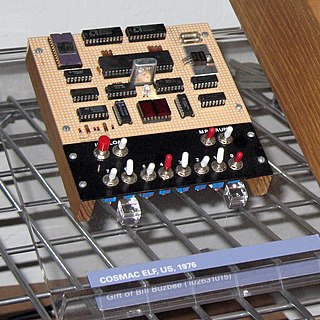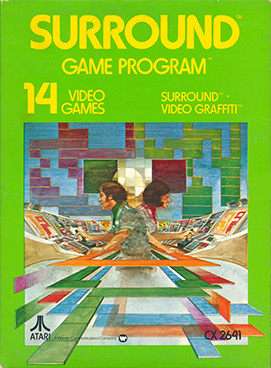
The Atari 2600 is a home video game console developed and produced by Atari, Inc. Released in September 1977 as the Atari Video Computer System, it popularized microprocessor-based hardware and games stored on swappable ROM cartridges, a format first used with the Fairchild Channel F in 1976. The VCS was bundled with two joystick controllers, a conjoined pair of paddle controllers, and a game cartridge—initially Combat and later Pac-Man. Sears sold the system as the Tele-Games Video Arcade. Atari rebranded the VCS as the Atari 2600 in November 1982 alongside the release of the Atari 5200.

Data East Corporation, also abbreviated as DECO, was a Japanese video game, pinball and electronic engineering company. The company was in operation from 1976 to 2003, and released 150 video game titles. At one time, the company had annual sales of 20 billion yen in the United States alone but eventually went bankrupt. The American subsidiary, Data East USA, was headquartered in San Jose, California. Its main headquarters were located in Suginami, Tokyo.

The COSMAC is an 8-bit microprocessor family introduced by RCA. It is historically notable as the first CMOS microprocessor. The first production model was the two-chip CDP1801R and CDP1801U, which were later combined into the single-chip CDP1802. The 1802 represented the majority of COSMAC production, and today the entire line is known simply as the RCA 1802.

The COSMAC VIP (1977) was an early microcomputer that was aimed at video games. Essentially, it was a COSMAC ELF with a supplementary CDP1861/CDP1864 video display chip. For a price of US$275, it could be purchased from RCA by mail order. It came in kit form, and had to be assembled. Its dimensions were 22 x 28 cm, and it had an RCA 1802 processor; along with a crystal clock operating at 1.76 MHz. It had 2 KB of RAM, which could be expanded to 4 KB on board, and 32 KB via an expansion slot. Its 5V DC CDP18S023 power supply had an output of 600 mA. I/O ports could be added to connect to sensors, interface relays, an ASCII keyboard, or a printer.

The COSMAC Elf was an RCA 1802 microprocessor-based computer described in a series of construction articles in Popular Electronics magazine in 1976 and 1977. Through the back pages of electronics magazines, both Netronics and Quest Electronics offered low-priced, enhanced kits that were based on this design. The system was a very early single-board personal computer. It was operated without built-in ROMs and programs were entered directly with help of the CPU integrated DMA using 8 toggle switches and an Input push button.

CHIP-8 is an interpreted programming language, developed by Joseph Weisbecker on his 1802 Microprocessor. It was initially used on the COSMAC VIP and Telmac 1800 8-bit microcomputers in the mid-1970s. CHIP-8 programs are run on a CHIP-8 virtual machine. It was made to allow video games to be more easily programmed for these computers. The simplicity of CHIP-8, and its long history and popularity, has ensured that CHIP-8 emulators and programs are still being made to this day.
1977 had sequels such as Super Speed Race and Datsun 280 ZZZAP as well as several new titles such as Space Wars. The year's highest-grossing arcade games were F-1 and Speed Race DX in Japan, and Sea Wolf and Sprint 2 in the United States. The year's best-selling home system was Nintendo's Color TV-Game, which was only sold in Japan.
Mirco Games Inc. was a manufacturer of coin-operated games based in Phoenix, Arizona founded in 1973. The company was a subsidiary of electronics manufacturer Mirco Inc, producing foosball tables and coin-operated video games through the 1970s. They notably created a few of the earliest games incorporating microprocessors, including The Spirit of ’76, the first commercially available pinball utilizing the technology. The company was eventually sold in 1980 to Amstar Electronics.

In the history of video games, the second-generation era refers to computer and video games, video game consoles, and handheld video game consoles available from 1976 to 1992. Notable platforms of the second generation include the Fairchild Channel F, Atari 2600, Intellivision, Odyssey 2, and ColecoVision. The generation began in November 1976 with the release of the Fairchild Channel F. This was followed by the Atari 2600 in 1977, Magnavox Odyssey² in 1978, Intellivision in 1980 and then the Emerson Arcadia 2001, ColecoVision, Atari 5200, and Vectrex, all in 1982. By the end of the era, there were over 15 different consoles. It coincided with, and was partly fuelled by, the golden age of arcade video games. This peak era of popularity and innovation for the medium resulted in many games for second generation home consoles being ports of arcade games. Space Invaders, the first "killer app" arcade game to be ported, was released in 1980 for the Atari 2600, though earlier Atari-published arcade games were ported to the 2600 previously. Coleco packaged Nintendo's Donkey Kong with the ColecoVision when it was released in August 1982.

Basic Math is an educational video game for the Atari Video Computer System. The game was developed at Atari, Inc. by Gary Palmer. The game involves a series of ten arithmetic problems involving addition, subtraction, multiplication, or division. The player can edit different gameplay modes to alter how the numbers in the problem are chosen, or if their questions are timed. The game was released in 1977 as one of the earliest releases for the console.
David Judd Nutting was an industrial design engineer who played a role in the early video game industry. He also designed the exterior of the Jeep Wagoneer.

Blockade is an arcade video game developed by Lane Hauck for Gremlin and released in November 1976. It is a two-player game where each player controls the direction of an arrow on the screen which creates a trail behind it. The object is the avoid any walls surrounding the playfield or created by each player for a select amount of turns. Blockade spawned many clones which came to be known as snake games.

Atari, Inc. was an American video game developer and home computer company founded in 1972 by Nolan Bushnell and Ted Dabney. Atari was a key player in the formation of the video arcade and video game industry.

Surround is a video game programmed by Alan Miller and published by Atari, Inc. for the Atari 2600. The game plays similarly to the arcade game Blockade (1976), which allows players to navigate a continuously moving block around an enclosed space as a wall trails behind it. Every time the opposite player has their brick hit a wall, the opposing player earns a single point, with the winner being the first to collect ten points.
APF Electronics, Inc. was a publicly traded company in the United States dedicated to consumer electronics. The company's name comes from the initials of the two brothers who founded the company, Al & Phil Friedman.

The Fairchild Channel F is a home video game console released by Fairchild Camera and Instrument in November 1976. It has the distinction of being the first programmable ROM cartridge–based video game console, and the first console to use a microprocessor. It was launched as the Fairchild Video Entertainment System, or Fairchild VES for short, but when Atari released their Atari Video Computer System, Atari VCS, later Atari 2600 the next year, Fairchild renamed its machine.
The RCA CDP1861 was an integrated circuit Video Display Controller, released by the Radio Corporation of America (RCA) in the mid-1970s as a support chip for the RCA 1802 microprocessor. The chip cost in 1977 amounted to less than US$20.
Joseph A. Weisbecker was an early microprocessor and microcomputer researcher, as well as a gifted writer and designer of toys and games. He was a recipient of the David Sarnoff award for outstanding technical achievement, recipient of IEEE Computer magazine's "Best Paper" award, as well as several RCA lab awards for his work.

Joyce Weisbecker is an American retired engineer and actuary. She became the first female commercial video game designer in 1976. She considers herself the first indie developer, given that she did her work as an independent contractor.















